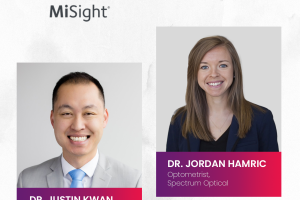
The Myopia Collective is leading change to elevate the new standard of care for children with myopia.1 And it’s calling on you to join the fight.
Wherever you practice, childhood myopia is prevalent and rapidly expanding.2-5 From small towns to big cities, many children with myopia who live in your communities are still undiagnosed or undertreated.6,7
Science has spelled out the potential ramifications that unchecked myopia can pose on vision and ocular health.8,9
But myopia can also create other significant hurdles for children in their immediate world, from impeded learning,10 to struggles with self-esteem.11-13 The challenge to change the trajectory of childhood myopia is here. But so too is the opportunity to help be a part of positive, lasting change.
In a groundbreaking partnership, CooperVision and the American Optometric Association (AOA) have joined forces to launch The Myopia Collective, an unparalleled, sweeping initiative with a core mission to rally the optometry profession and its allies to challenge existing norms and elevate the standard of care for children with myopia.1
“The myopia epidemic will go largely unchecked without the active involvement of every single member of the profession”, says Dr. Michele Andrews, Vice President, Professional and Government Affairs, Americas, CooperVision.
“It takes all of us to make a big enough difference,” Dr. Andrews continues. “A ‘dent’ isn’t enough. We’ve created The Myopia Collective as a movement to rally the entire profession of optometry to elevate the standard of care for children with myopia.1 Together, we will shift focus from simple vision correction to embracing comprehensive treatment.”
“The prevalence of myopia is increasing in the United States and worldwide,2 creating more near-term vision issues and longer-term ocular health risks,”1-4,9 explains AOA president, Dr. Steven T. Reed, OD.
“Concerningly, the data demonstrates the number of children receiving eye health and vision care has decreased in recent years,”14 Dr. Reed continues. “Doctors of optometry across the country provide more than two-thirds of primary eye health and vision care and take a leading role in patient care.15 The AOA recognizes we are at a critical point in time in relation to children’s eye health needs, requiring strong action and a mobilization of the profession of optometry.”
Here, Dr. Andrews and Dr. Reed share their why behind The Myopia Collective, the sense of urgency for the profession to boldly act now, and how you can join the fight.

Become Part of the Change
Changes agents will be the faces of The Myopia Collective, Dr. Andrews explains. The Change Agents will be optometrists from every state who are motivated to expand myopia management within their own practices while also engaging their communities and legislators.
“We’re going to invest in making sure Change Agents have the techniques, tools, and support to cut through the noise and make our voices heard, starting with an exclusive educational workshop this September,” Dr. Andrews notes. “From there, we’re going to help Change Agents remain at the forefront of this movement—in their towns and cities, in the media, in the halls of their state capitals, on the podium, and everywhere else that the fight for children’s sight takes us.”
Doctors of Optometry are at the frontlines of patient care and play a primary role in diagnosis, clinical management and treatment of this increasing public health threat, Dr. Reed adds.
“Through The Myopia Collective, we are empowering doctors with the tools to increase needed access to advanced myopia management care where they are and work as a collective to change the course of this challenge across the country,” he says. “We want you to be part of the team and part of the solution to addressing the eye health and vision needs of all children. There is a role for all of us.”
Every individual within the optometric profession, regardless of credential or role, are encouraged to join The Myopia Collective as Members, who will gain access to relevant education and resources.
Leaders Unite to Advance Lasting, Meaningful Change in Childhood Myopia
CooperVision and AOA are longtime partners in advancing patient health, Dr. Andrews notes.
“The AOA’s partnership in The Myopia Collective alongside all of us at CooperVision underscores the importance of safeguarding eye health and vision care for Americans both today and in the decades to come,” she continues. “This is what our communities, our children, and the optometric profession deserve.”
CooperVision and the AOA have a shared commitment to tackle the threat myopia poses and work together to architect innovative solutions to the challenge, Dr. Reed says. “This is why we are thrilled about The Myopia Collective.”
“One of AOA’s advocacy strengths is having Doctors of Optometry in every congressional district,” he adds. “When it comes to making real changes in clinical care, we need to draw from the power of our doctors across the country.”
“When you enroll a child in a myopia control intervention, you’re doing more than improving the child’s vision and increasing their chances of better ocular health later in life,” Dr. Andrews explains. “You’re shining light into parts of their daily lives that might have gone dark, giving children the power, the spirit, and the confidence to thrive. It’s a gift that we alone can give—and it’s here for the giving."
A Core Mission for All
The Myopia Collective requires an all-hands-on-deck approach, from industry to advocacy, to eye care professionals, their staff, and passionate community members from every state and territory… including you.
“As the primary eye health care authority, the AOA and our doctors of optometry see this bold initiative with CooperVision as an innovative and necessary strategy to address a crisis that requires strong partnerships and engagement from everyone,” Dr. Reed stresses. “We invite you to be a part of this revolution and be a Change Agent with us.”
“When you enroll a child in a myopia control intervention, you’re doing more than improving the child’s vision16 and increasing their chances of better ocular health later in life,” Dr. Andrews explains. “You’re shining light into parts of their daily lives that might have gone dark, giving children the power, the spirit, and the confidence to thrive. It’s a gift that we alone can give—and it’s here for the giving.”
She adds, “Take this important step toward leading this change with us. Be part of the change, part of the experience, part of the movement that changes lives.”
Find out more about The Myopia Collective and how you can apply to become a Change Agent here.

The Myopia Collective: Five Essentials You Need to Know
1. What is The Myopia Collective? A new bold collaboration between the AOA and CooperVision which seeks to mobilize the optometry profession and its allies to interrupt the status quote and advance the new standard of care for children with myopia.1 Together, we will shift focus from simple vision correction to embracing comprehensive myopia control treatment.
2. Who can join the Collective? Every individual within the optometric profession, regardless of credentials or role, is invited to join The Myopia Collective. Membership provides access to relevant education, tools and resources, and keeps you connected to the work of the Collective and its Change Agents.
3. What are Change Agents? Change Agents play an important role in The Myopia Collective. These ambassadors will receive specialized training in myopia management to advance myopia treatment offerings within their practices and lead legislative and community advocacy efforts. One or two Change Agents will be selected per U.S. state and several territories, ensuring cross-country representation.
4. When are the deadlines to apply? Optometrists with a strong motivation to integrate myopia management into their practices and to take more active roles in transforming the lives of children and families are encouraged to apply by May 17, 2024. Change Agents will be announced in June at Optometry’s Meeting®.
5. What can I expect if I’m selected? The inaugural Change Agent workshop will take place over a weekend in Chicago in September. From there, we’re going to help our Change Agents remain at the forefront of the movement—in their practices, towns and cities, in the media, in the halls of their state capitals, on the podium, and so much more.
Find out more here
References:
1. Resolution: The standard of care for myopia management by optometrists. World Council of Optometry. May 17, 2021. https://worldcouncilofoptometry.info/resolution-the-standard-of-care-for-myopia-management-by-optometrists. Accessed April 12, 2024.
2. Holden, BA, Fricke TR, Wilson DA, et al. Global prevalence of myopia and high myopia and temporal trends from 2000 through 2050. Ophthalmology. 2016 May;123(5):1036-42.
3. Fricke TR, Jong M, Naidoo KS, et al. Global prevalence of visual impairment associated with myopic macular degeneration and temporal trends from 2000 through 2050: systematic review, meta-analysis and modelling. Br J Ophthalmol. 2018;102(7):855-862.
4. Ma Y, Qu X, Zhu X, et al. Age-specific prevalence of visual impairment and refractive error in children aged 3-10 years in Shanghai, China. Invest Ophthalmol Vis Sci. 2016;57(14):6188-6196.
5. Casey Eye Institute. Myopia is on the rise, especially amongst children. June 3, 2022. https://www.ohsu.edu/casey-eye-institute/myopia-rise-especially-among-children. Accessed April 8, 2024.
6. Fortin P, Kwan J. The Myopia management opportunity in the United States using the 2020 Census. ARVO Meeting Poster 2022.
7. Kwan J, Sulley A, Young G, Greenaway N. Current trends in pediatric eye examinations and contact lens prescribing in the U.S. Poster. Global Specialty Lens Symposium 2024.
8. Bullimore MA, Brennan NA. Myopia Control: Why Each Diopter Matters. Optom Vis Sci. 2019 Jun;96(6):463-465.
9. Tideman JW et al. Association of axial length with risk of uncorrectable visual impairment for Europeans with myopia. JAMA Ophthalmol. 2016;134:1355-1363.
10. Congdon N, Burnett A, Frick K. The impact of uncorrected myopia on individuals and society. Community Eye Health. 2019; 32(105): 7–8.
11. Dias L, Hyman L, Manny RE, et al. Evaluating the self-esteem of myopic children over a three-year period: The COMET Experience. Optom Vis Sci. 2005 Apr;82(4):338-347.
12. Dias L, Manny RE, Weissberg E, et al. Myopia, contact lens use and self-esteem. Ophthalmic Physiol Opt. 2013 Sep; 33(5):573-580.
13. Walline JJ, Jones LA, Sinnott L, et al. Randomized trial of the effect of contact lens wear on self-perception in children. Optom Vis Sci. 2009 Mar;86(3):222-32.
14. Chauhan MZ, Elhusseiny AM, Samarah ES, et al. Five-year trends in pediatric vision screening and access in the United States. Ophthalmology. 2023 Jan; 130(1): 120–122.
15. American Optometric Association. State Advocacy. Accessed April 12, 2024. https://www.aoa.org/advocacy/state?sso=y
16. Chamberlain P, et al. A 3-year randomized clinical trial of MiSight® lenses for myopia control. Optom Vis Sci. 2019; 96(8):556-567







